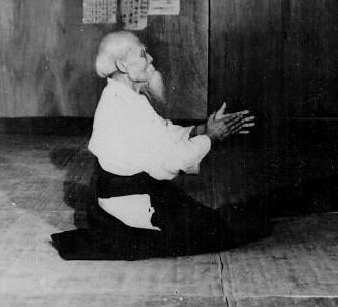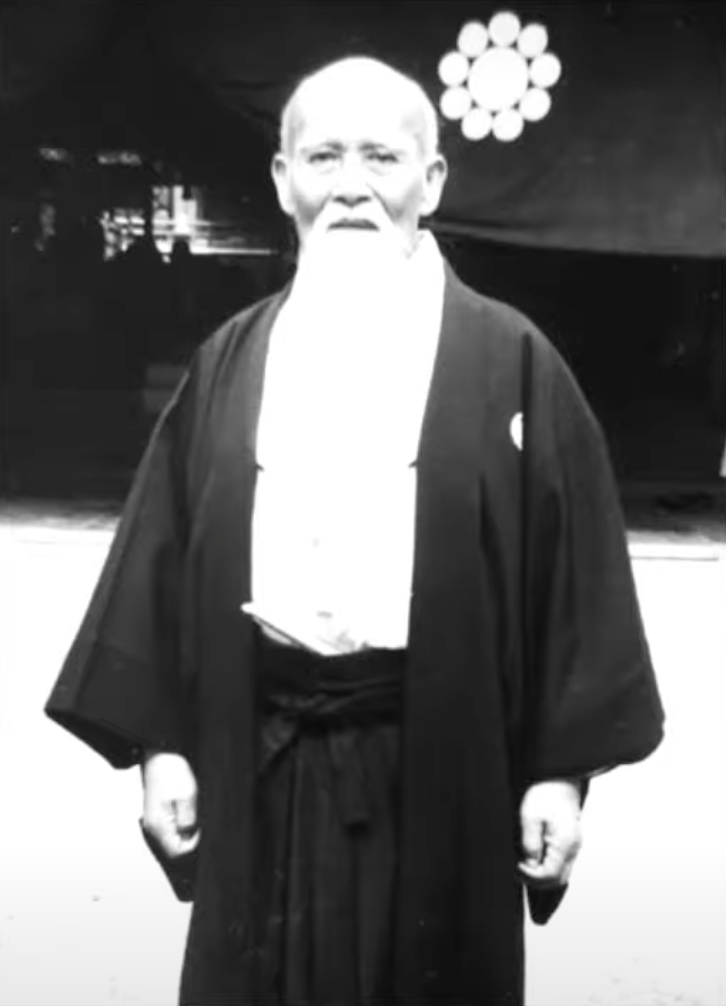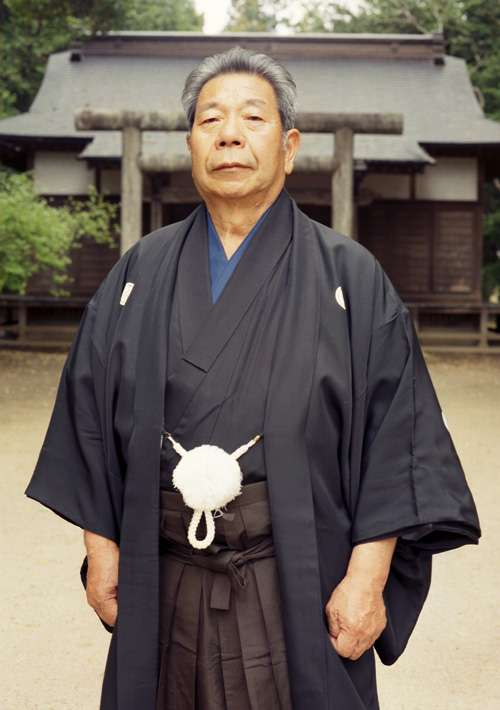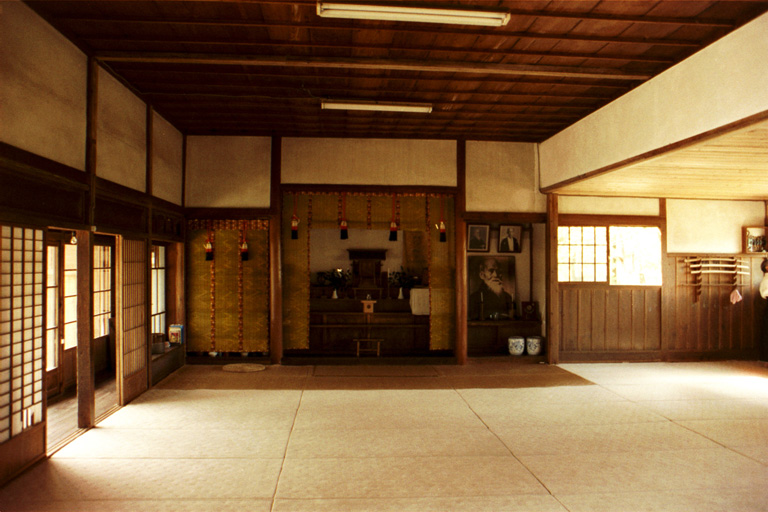Proper manners and consideration for others are highly valued by the Japanese. “Reiho”, literally ‘the way to behave’, could even be viewed as a spiritual practice, a work of art, a state of mind, a way of being in the world. This cultural attitude is especially apparent in the martial arts, including the practice of Aikido.
O’Sensei’s Precautions For Training
I think it is worth mentioning that The Founder of Aikido, Morihei Ueshiba, was posthumously bestowed with the “Order of the Sacred Treasure” (瑞宝章, Zuihō-shō). That is, O’Sensei was considered a National Treasure, a personality who embodied the Spirit of Japan. The following precautions appear in “Budo” (translated by John Stevens), Morihei Ueshiba O’Sensei’s 1938 training manual:
- The original intent of Bujutsu [martial arts] was to kill an enemy with one blow; since all techniques can be lethal, observe the instructor’s directions and do not engage in contests of strength.
- Bujutsu is an art in which the one is used to strike the many. Therefore, train yourself always to be mindful of, and alert to, opponents in the four and the eight directions.
- Always train in a vibrant and joyful manner.
- The instructor can only impart a small portion of the teaching; only through ceaseless training can you obtain the necessary experience allowing you to bring these mysteries alive. Hence, do not chase after many techniques; one-by-one, make each technique your own.
- In daily training, begin with basic movements to strengthen the body without overexertion. Spend the first ten minutes warming up, and there will be no fear of injury, even for old people. Enjoy yourself in training and strive to comprehend its true purpose.
- Training in Bujutsu is to foster yamato-damashii (the ancient spirit of Japan; all that is good and true in human nature) and to build one’s character. The techniques are transmitted from person to person, on an individual basis, and should not be disclosed indiscriminately to the public. Such secret techniques should not be misused for evil purposes.
Practical Guidelines
Practicing etiquette from a culture other than one’s own can be daunting. In the beginning it is ok not to know what to do, it takes time for behaviour to become routine and feel natural. It may be the case too that different customs and practices are observed from dojo to dojo. Some Sensei are very strict! I think a couple of general principles are worth keeping in mind:
1. Be humble and respectful, try to approach each situation with an open mind and heart, try not to take corrections as a personal attack, rather as an opportunity for growth and learning;
2. Watch carefully the behaviour of more senior students and try to take their lead as best you can.
(If you are interested in the deeper meanings of Japanese etiquette, you may find interesting some of the links in the References section at the bottom of the article.)
The Dojo
“Dojo” literally means “a place of the way”. It is here that training takes place. When speaking of Dojo Etiquette, it is concerned with behaviour while in this space.
The diagram below shows the layout of a traditional Dojo:
Glossary
Kamiza = High seat, God (Spirit) seat; Kamidana = God (Spirit) shelf; Shomen = front, front of head; Joseki = Upper area; Shimoseki = Lower area; Embujo = Centre area, Theatre, Playhouse; Shimoza = Bottom seat.
Ojigi Or Bowing
Ojigi (お辞儀) is a fundamental part of social etiquette in Japan, one of the defining qualities of adulthood is the ability to bow correctly and elegantly. There are broadly two types of Japanese bow, zarei (座礼), bowing while kneeling, and ritsurei (立礼), bowing while standing. In either case, it is considered essential to keep one’s back and neck completely straight during the bowing gesture, bending one’s body only at the waist. Failure to do so can be thought of as an indication of lethargy, insincerity and even disrespect. Slouching backs and protruding hips are both considered ugly.
You should always bow in proper reference to the Kamiza and Shimoza, i.e. bow facing East and West, never with your rear to Kamiza, or at an angle to Kamiza.
You should always bow with your whole body facing properly towards your partner.
Aside: Rei-sansoku (礼三息), or bow in three breaths, alludes to the importance of breathing correctly while performing the bow. The downward motion to be as long as a natural inhale, remaining still in the bow position for an exhale, and finally inhaling to return to the original stance. This practice ensures that ojigi feels neither rushed nor too long.
Standing Bow – Ritsurei
As one might expect, the deeper the standing bow the more respectful. Saikeirei is reserved for bowing to important persons, asking forgiveness or a favour, and one is expected to stay longer in the down position to show respect and sincerity.
Men should keep their hands to their sides, and women can place one hand on top of another below the abdomen.
Seiza & Zarei – Sitting and the Seated Bow
In the video below Guillaume Erard Sensei provides excellent information regarding sitting and performing the seated bow in Aikido.
Aside: As with the standing bow, the seated bow has three styles, shin (真), the most formal style, gyō (行) the intermediate style, and sō (草), the most casual style. The most formal style has one’s face about 5cm from the floor (as in the video above). Gyō (行) has one’s hands in the same position and one’s face about 30cm from the floor. Sō (草) as the most informal has one leaning forward so that only the fingertips touch the floor, men in front of the knees and women with their hands together in the center.
Cleanliness:
“Cleanliness is next to Godliness”, the Japanese certainly regard cleanliness as an important part of religious practice. You should not enter the dojo if you are dirty.
The Dojo must be kept clean. It is the responsibility of the students to keep the Dojo clean. Follow and help with the cleaning routines and practices of the Dojo.
Keep your keiko-gi clean at all times. If wearing a hakama, the pleats should be kept neat.
Keep your finger and toe nails short. Especially in techniques such as irimi-nage where you grab the collar of your partner, long finger nails easily scratch the back of the neck. Or in Tai-no-henko / ura waza techniques, stepping toe-to-toe can be tricky negotiating long toe nails!
Arriving at the Dojo:
Arrive at the dojo in good time to assist with preparing the Dojo for training.
Entrance to the dojo is gained via the Shimoza. Remove your shoes before stepping into the Dojo. It is often said, and really good advice, that one should leave one’s ego along with one’s shoes! Also remove your hat, earphones, etc.
Raise your awareness before stepping into the dojo. Following the principle that you should be in the same room as that of the person to whom you are bowing, it is not necessary to perform a bow or “Rei” outside of the dojo. Do not bow over the sill or threshold of the doorway. Rather, step into the dojo with your left foot first then place your right foot next to your left and perform a standing bow – Saikeirei – towards the Kamiza. If you are carrying bags on your shoulders take these off and hold them in your hands before performing the standing bow.
Aside: Stepping in with your left foot first follows the etiquette for example of Zen Dojo as practiced by Master Taisen Deshimaru. Iaido practitioners may follow the practice of entering the dojo with their right foot first, reasoning that the sword/katana is drawn by stepping forward with your right foot. Stepping into the dojo with your left foot first is symbolic of a peaceful mind/attitude.
Walking in the Dojo:
After entering the dojo do not walk immediately onto or across the mat. Rather walk to the sides. Pay attention to other people who may already be in the dojo. If the Sensei or Senpai is present in the dojo approach them and perform a greeting, e.g. Konichiwa.
If there are people conversing in the dojo, do not pass in between them. If you do not have a choice, bend down so as not to cross their line of sight. Generally one should not pass or stand between the Kamiza and the Sensei. This, of course is not always possible in practice.
Be careful about passing or standing too close behind someone. Of course from a martial arts perspective, this can be an unpredictable and uncomfortable situation.
Aside: When visiting a Japanese shrine and approaching the Torii (gate), perform a standing bow on the left, and then step over the threshold with your left foot first. Walk to the left side of the path. The middle of the path is considered to be where the Kami pass.
Walking in Dojo with Weapons
Bokken: When walking with the Bokken off the mat, it must be carried in the right hand, blade side facing down to the ground with handle up behind you and the tip down in front. This signifies that you have no intention to fight, because it would take a very long time to draw the sword from this position.
Jo: The Jo is much longer than the bokken so please pay attention when walking around the dojo. The Jo does not have a front or back side, and it is not drawn. To all intents and purposes it is a walking staff, and so does not have the same reverential status as the sword. That being said however, off the mat, hold the Jo in your right hand with one end facing down and the other up to the rear of your shoulder. Make sure that the top of the Jo is not visible above your shoulder.
Putting your bags and equipment down:
Do not just throw your bags down, rather orientate your body appropriately and place your bags on the floor. Training equipment should be stored neatly on the Shimoza.
Getting Dressed/Changed:
Wearing keiko-gi outside the Dojo Is frowned upon, however if it is covered, that is acceptable.
You should change into your keiko-gi in the changing room, not in the dojo. Definitely do not be naked or in your underwear in the dojo.
Your keiko-gi should be put on correctly, and Obi (belt) tied correctly. Take note that the left lapel crosses over the right, not the right over left as this is only for those deceased!
Women must wear a T-shirt underneath their keiko-gi. Men should refrain from wearing T-shirts under their keiko-gi.
In the course of training is often happens that your keiko-gi becomes out of shape, perhaps you need to re-tie your obi (belt). When needing to do this, turn away from the Kamiza and adjust your keiko-gi.
Footwear:
Generally, when in keiko-gi you should be wearing zori, except of course when you are on the tatami mats. When stepping off the tatami please wear your zori.
Practice in bare feet. Unless under special circumstances, for instance if injured, you should not wear tabi (Japanese socks) or socks during keiko.
When training outdoor buki waza (weapons), Saito Sensei, in his later years, required that deshi (students) wear closed shoes, not zori.
Jewellery:
All jewellery should be removed before practice.
Stepping onto the Tatami mat:
It may depend on the layout of your particular dojo, for example, the entire dojo may be covered with tatami mat (in which case you have already stepped onto the mat by entering the dojo), or there may be a central area which has tatami mats with un-matted areas surrounding. In the case where you are approaching a matted area in zori (slippers / sandals / flip-flops), turn your back to the mat so that you can remove the zori so they are facing outwards and you can step onto the mat. Perform a standing or sitting bow. (See “Arriving Late” below for additional guidelines.)
Stepping onto the mat with Weapons
Bokken: When stepping onto the mat (left foot first) or towards the training area, hold the bokken out in front of you parallel to the ground, palms up, the blade side facing towards you and the hilt to your left. Perform a standing bow towards the Kamiza. Now place the bokken in your left hand, blade side facing up and hilt out in front of you. Step forward now with your right foot.
Jo: Follow the same method as the bokken. When holding the Jo out in front of you, pay attention to your surroundings.
Lining Up:
Students should be lined up and sitting quietly in seiza before Sensei steps onto the mat. For the method of how to move from a standing position to seated, please see the above video instruction of Guillaume Erard Sensei.
Higher grades sit at Joseki and lower grades to Shimoseki, i.e. in descending order from right to left. In the case of the same rank, the person who received the rank first, according to the date on the diploma, is considered senior. In the case of having received the rank at the same time, then it is the person who enrolled first. In the case of the same rank and same time of enrolment, then it is the person who is oldest.
Lining up with Weapons
Bokken: Place the bokken out in front of you with the blade side facing towards you and the hilt to your left. It is considered impolite to have the blade side facing the Kamiza. Allow enough space between you and the bokken so that you can put your palms on the floor to perform a seated bow. Do not put your hands and arms over the bokken, it must be out in front.
Aside: When pacing or holding the bokken out in front of you, the reasoning behind having the hilt to your left is that it’s very difficult to draw a sword from this position. Assume this position too if you are passing the bokken or sword to someone else. It is polite because it puts you at a disadvantage and the other person at an advantage.
Jo: Place the Jo on the mat out in front of you, allow enough space so that you can perform a seated bow.
Opening & Closing Formality (Following Saito Sensei):
In the majority of dojo’s who follow the pedagogy of Morihiro Saito Sensei, there is a formal seated bowing ceremony at the beginning and end of the class. The method is the same as when bowing before a Shinto shrine. That is, there are two bows, then two claps, followed by one bow.
When clapping, the right hand slides down slightly so that the left hand fingers are further forward. The left hand symbolises heaven or the divine qualities, the right hand the individual or ego taking a lower position. Once the claps are completed, the right hand slides up in prayer position and the formal seated bow is performed once more.

After the final bow towards the Kamiza the students remain down in the bow position. The Sensei turns and bows towards the deshi (students), at the start of the class everyone says “Onegai-shimasu” (please), and at the end of the class everyone says “Domo arigato gosaimashita” (Thank you). First the Sensei raises from the bow, then the most senior student and like a wave in succession of rank each student sits up in seiza.
A tip for those sitting in line, always look to your right as you’ll want to follow the senior students lead. If the senior students, for example, are down in seated bow then do as they do, when they come up, you come up.
Sitting in the Dojo:
There are only two options for sitting in the dojo, either in formal Seiza, or sitting with your legs crossed. Do not sit with your feet outstretched in front of you, especially with the soles of your feet facing the Kamiza, this is considered rude. Do not lay about in the dojo.
Sitting with Weapons
For both the Bokken and Jo, when sitting in seiza observing Sensei’s demonstration, the weapon must be placed close along your left side. With the bokken, the blade side must be turned towards your body. Pay attention to how far your weapon is sticking out in front and behind you, make sure that it is not in the way of others.
Body Postures:
Keep your body straight, do not slouch. Do not lean against the dojo walls. Avoid folding your arms, either when in seiza or standing. Especially avoid this when Sensei is demonstrating/teaching as this is considered rude behaviour. Also avoid putting your hands on your hips, rather your arms should be down to your side.
When training in a group of three or more, while you are waiting do not sit in seiza, you will be in the way. Rather stand to the side and await your turn to practice.
When standing you can observe the practice of placing your thumb inside folded fingers. This protects your thumb from being grabbed.


Arriving late:
On occasion you may arrive to the dojo late. When arriving try to be as inconspicuous as possible. Do not come crashing through the doorway, especially if Sensei is teaching or demonstrating. If you arrive at the doorway and Sensei is teaching, wait until practice has resumed and then enter. Walk to the side of the dojo out of the way to get changed. Again coming from the change room do not enter the dojo when Sensei is teaching. Once you are ready, stand to the side of the mat on Shimoza side and await for Sensei to invite you onto the mat. Perform the traditional bow in as in the start of the class, i.e. two bows, two claps, one bow. taking care not to clap too loudly as to draw attention to yourself. You may then join the class.
Eating & Drinking:
One should not eat food in the dojo. If you need to drink water then this should be done to the side of the mat.
Aside: On special occasions a party can be held inside the dojo for students where food and drink are served. Particular care must be taken not to dirty the mats.
Leaving the Mat During Practice:
Always obtain permission before leaving the mat. Wear zori when leaving the mat.
Interacting with Sensei During Training:
If you have a question you need to ask Sensei, do not wave and call Sensei over from the other side of the mat. Rather walk over, perform a bow and make your request.
If you are called upon to assist in demonstration, perform a seated bow and move quickly to Sensei. Once the demonstration is complete, face sensei and perform a seated bow. Do not have your back turned to the Kamiza when performing the bow.
During class when Sensei signals to stop practicing pay attention to your partner to confirm that they are also aware to stop practicing, or you may receive a blow. Try not to waste time, bow to your partner, sit in seiza and wait to receive instruction.
If Sensei makes a correction to your technique, say “hai” (yes), and “domo arigato gozaimasu”. Try not to make excuses for why you have been corrected.
Interacting with fellow practitioners:
When Sensei indicates to commence practice, turn to face your partner and perform a seated bow facing east-west, i.e. don’t have your rear turned to the Kamiza.
- Be courteous with your fellow practitioners.
- Do not engage in contests of strength.
- Be helpful to beginners.
- Do not chat or talk unnecessarily.
Leaving the Dojo:
After training and the closing formal bow, turn to the last partner you practiced with and perform a seated bow. If you have a hakama, fold it on the mat. Help with any clearing up or cleaning activities required.
When leaving the mat, perform a standing bow towards the Kamiza, turn and step into your zori. Get changed. When preparing to leave the Dojo entrance, turn to face the Kamiza and perform a standing bow. Step out with your left foot first. Try to maintain the peaceful attitude and lessons gained through your practice in the dojo out into the world. In this way the practice of martial arts (Budo) is beneficial to society as a whole.
References
Rules of the Dojo, Master Taisen Deshimaru, 1988.
Reiho (Method of Etiquette) Reishiki: (Etiquette, Politeness, Manners, Form of Etiquette) In the Dojo,
By Hiroshi Isoyama Sensei, 8th Dan Aikikai Shihan, Ibaraki Shibu Dojo, Translated by Ethan Monnot Weisgard.
Manners to follow when visiting a shrine in Japan, 2020.
The Traditional Dojo, by Walther von Krenner, 2021


